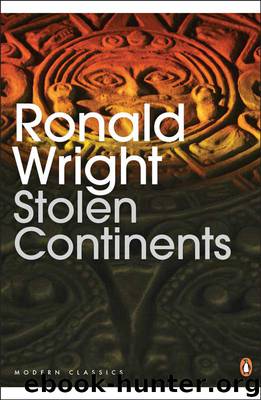Stolen Continents by Ronald Wright

Author:Ronald Wright
Language: eng
Format: epub
Publisher: Penguin Canada
The messages were similar to those heard in other parts of the Americas in crisis—the Taki Onqoy of Peru, the Aztec prophecies of the 1530s, Waman Puma’s appeal. The Creator, Tsali said, had made different peoples in different lands; the presence of whites in America was unnatural and wrong. The Master of Life never intended Indians to live like whites; the ills he sent would vanish only when the Indians returned to their own ways.
Many had doubts about Tsali’s teachings. Progressives were openly scornful. Then, in August 1811, a comet blazed in the sky for weeks, and in December earthquakes shook the mountains. Soon after that a doubter known as the Duck fell dead in public. He died, significantly, at Etowah, the large Cherokee town surrounding the great earthen pyramids that Soto may have climbed.
A similar movement took hold among the Cherokees’ neighbors and traditional enemies, the Creeks. It was influenced by the Shawnee prophet Tenskwatawa, a brother of Tecumseh. Like the prophet who had inspired Pontiac fifty years before, he spoke of a final war to drive out the invaders.22 Whites, the Creator had told him, “are not my children, but the children of the evil spirit. They grew from the scum of the great water…. They are numerous, but I hate them. They are unjust; they have taken away your lands which were not made for them.”23
The Creek Nation, which still held most of Alabama and parts of Georgia, had also been following the acculturation path. A serious split had developed between wealthy progressives and militant antiacculturation Red Sticks, so named for their vermilion war clubs. When the Red Sticks saw the whites embroiled in the War of 1812, they rebelled against the chiefly establishment and began to carry out the prophet’s commands: “Kill the cattle … destroy the wheels and looms, throw away your ploughs and everything used by the Americans.”24 When the Red Sticks wiped out a United States garrison at Fort Mims in 1813, the Creek civil war became part of the larger war in North America.
The Cherokee Nation was torn by similar divisions, but although the ghost dance revived certain customs and forced many Cherokees to think hard about where they were going, it did not bring armed conflict with progressive chiefs or the United States. Remembering the Revolutionary War, the Cherokees judged that the Americans would win again. If they proved themselves loyal allies, they reasoned, surely the United States would cease its effort to uproot them from their ancient home.
In 1813 several hundred Cherokees enlisted under the command of a bush lawyer turned general, Andrew Jackson. Old Hickory, as he became known for his intractable personality, was forty-six, gaunt, shrewd, violent, one arm crippled by dueling wounds—the latest from a duel with his own brother. Of Carolina frontier stock, he hated Indians but was more than willing to employ them as high-grade cannon fodder. His Creek War, hailed by Jackson as a victory for civilization, was notorious for the savagery of white troops under his command.
Download
This site does not store any files on its server. We only index and link to content provided by other sites. Please contact the content providers to delete copyright contents if any and email us, we'll remove relevant links or contents immediately.
| Africa | Americas |
| Arctic & Antarctica | Asia |
| Australia & Oceania | Europe |
| Middle East | Russia |
| United States | World |
| Ancient Civilizations | Military |
| Historical Study & Educational Resources |
Cat's cradle by Kurt Vonnegut(14777)
Pimp by Iceberg Slim(13798)
Underground: A Human History of the Worlds Beneath Our Feet by Will Hunt(11846)
4 3 2 1: A Novel by Paul Auster(11812)
The Radium Girls by Kate Moore(11634)
Wiseguy by Nicholas Pileggi(5328)
American History Stories, Volume III (Yesterday's Classics) by Pratt Mara L(5141)
Perfect Rhythm by Jae(5080)
The Fire Next Time by James Baldwin(5027)
Paper Towns by Green John(4808)
Pale Blue Dot by Carl Sagan(4628)
A Higher Loyalty: Truth, Lies, and Leadership by James Comey(4562)
The Mayflower and the Pilgrims' New World by Nathaniel Philbrick(4286)
The Doomsday Machine by Daniel Ellsberg(4252)
Killers of the Flower Moon: The Osage Murders and the Birth of the FBI by David Grann(4194)
Too Much and Not the Mood by Durga Chew-Bose(4099)
The Sympathizer by Viet Thanh Nguyen(4096)
The Borden Murders by Sarah Miller(4029)
Sticky Fingers by Joe Hagan(3916)
